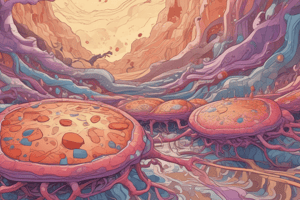Podcast
Questions and Answers
What is the total number of lectures in the Pathology curriculum?
What is the total number of lectures in the Pathology curriculum?
- 20 (correct)
- 25
- 16
- 15
What is the percentage of the Final written exam in the Pathology assessment?
What is the percentage of the Final written exam in the Pathology assessment?
- 50
- 20
- 40 (correct)
- 30
What is the main purpose of special stains in microscopic picture?
What is the main purpose of special stains in microscopic picture?
- To demonstrate the shape of the tissue
- To demonstrate the size of the tissue
- To demonstrate intra and extra cellular materials (correct)
- To demonstrate the color of the tissue
What is the study of the obtained diseased tissue regarding size, site, shape, and others?
What is the study of the obtained diseased tissue regarding size, site, shape, and others?
What is the universally used stain in Microscopic picture?
What is the universally used stain in Microscopic picture?
Which of the following stains is used for glycogen and basement membranes?
Which of the following stains is used for glycogen and basement membranes?
What is the purpose of Immunohistochemistry?
What is the purpose of Immunohistochemistry?
What type of biopsy involves removing a whole diseased tissue?
What type of biopsy involves removing a whole diseased tissue?
What is the main purpose of Autopsy?
What is the main purpose of Autopsy?
What type of specimens are examined in cytology?
What type of specimens are examined in cytology?
Study Notes
Pathology Curriculum Map
- The curriculum map consists of 16-20 lectures divided into 10 chapters
- The chapters include Introduction, Cell injury, Tissue deposits, Inflammation, Repair, Disorders of growth, Neoplasia, Disorders of blood flow, Infectious diseases, and Environmental & nutritional diseases
Pathology Assessment Map
- The assessment map consists of a final written exam (40%), oral sheet (10%), practical exam (25%), midterm (15%), and course work (10%)
Pathology
- Etiology involves predisposing factors, exciting factors, pathogenesis, clinical picture, and prognosis
- Clinical picture includes symptoms, signs, and complications
- Pathogenesis involves mechanism, morphology, gross picture, and microscopic picture
Gross Picture
- Gross picture is the study of obtained diseased tissue regarding size, site, shape, surface, capsule, color, consistency & borders, and cut section
Microscopic Picture
- Microscopic picture involves histopathological features and structural changes in tissues and organs
- H & E stain is universally used
- Special stains are used to demonstrate intra & extra cellular materials:
- Periodic acid Schiff stain (PAS) for glycogen and basement membranes
- Trichrome stain for collagen
- Prussian blue reaction for hemosidrin
- Alcian blue stain for mucin
- Sudan III & Osmic acid for lipids
- Congo red stain for amyloid
- Immunohistochemistry is the application of immunologic principles and techniques to the study of cells and tissues
- Immunohistochemistry is useful in diagnosis of malignant undifferentiated tumors, classification of tumors, detection of primary site of metastatic deposits, planning therapeutic protocols, and prediction of tumor behavior & response to therapy
- Immunostaining may be nuclear, cytoplasmic, or membranous
Specimens
- Types of pathological specimens include tissue and cellular specimens
- Tissue specimens include whole organ, biopsy, and autopsy
- Biopsy is a sample from affected tissue and can be excision biopsy or incision biopsy
- Incision biopsy can be punch biopsy, endoscopic biopsy, or core cut needle biopsy
- Autopsy involves postmortem specimens taken from organs and tissues to determine the cause of death
- Cellular specimens (cytology) involve examination of diseased cells and include exfoliated cells, cells in body fluids, effusion fluid, and body discharge
Studying That Suits You
Use AI to generate personalized quizzes and flashcards to suit your learning preferences.
Description
This quiz covers the basic concepts of pathology, including cell injury, tissue deposits, inflammation, repair, and disorders of growth. It is designed for students in the Pathology Curriculum map, Spring 2023-2024.




